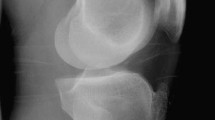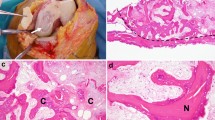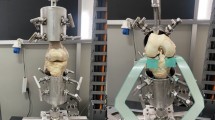Abstract
Background
Knee pain is one of the commonest symptoms in patients who attend the Orthopaedic outpatient clinics. Chondral defects result in a painful knee. Incidence of chondral defect is reported to be between 5 and 10% over the age of 40. It is well documented that chondral defects can lead to osteoarthritis. Early detection of these lesions and cartilage repair surgery can delay the onset of osteoarthritis. The purpose of this study is to highlight the incidence, associations and correlations between opposing cartilage defects in patients who present to the knee clinic with pain.
Methods
A retrospective analysis was carried out on patients who had Magnetic Resonance Imaging scans for painful knees between June 2017 and May 2019. About 227 consecutive knees were studied for the incidence of chondral defects, number of lesions, grade and size of lesion, geographical location and associated pathology in the knee.
Results
All the 227 patients had chondral lesions. Most patients had 2–3 lesions (66.1%) with patellar lesions (76.6%) being the commonest followed by medial femoral condyle (59.9%). Significant correlation was found in grade and size between opposing surface lesions in patella-trochlea, Medial Femoral Condyle-Medial Tibial Plateau and Lateral Femoral Condyle-Lateral Tibial Plateau. Females were more predisposed to patella lesions. Significance between age and lesions were established.
Conclusion
Incidence of cartilage defects in the knee is very high. Kissing lesions must be considered when treating cartilage lesions. Volume index could be a promising method to quantify lesions.



Similar content being viewed by others
References
Davis MA, Ettinger WH, Neuhaus JM et al (1989) The association of knee injury and obesity with unilateral and bilateral osteoarthritis of the knee. Am J Epidemiol 130:278–288. https://doi.org/10.1093/oxfordjournals.aje.a115334
Vaishya R (2016) The journey of articular cartilage repair. J Clin Orthop Trauma 7:135–136. https://doi.org/10.1016/j.jcot.2016.06.001
Shanmugasundaram S, Vaish A, Chavada V et al (2021) Assessment of safety and efficacy of intra-articular injection of stromal vascular fraction for the treatment of knee osteoarthritis-a systematic review. Int Orthop 45:615–625. https://doi.org/10.1007/s00264-020-04926-x
Kambhampati SB, Vaishya R, Saseendar S, Vaish A (2020) What's New in the Management of Articular Cartilage Injuries in Athletes. J Postgrad Med Edu Res 54(4):218–226
Minas T, Gomoll AH, Rosenberger R et al (2009) Increased failure rate of autologous chondrocyte implantation after previous treatment with marrow stimulation techniques. Am J Sports Med 37:902–908. https://doi.org/10.1177/0363546508330137
Outerbridge RE (1961) The etiology of chondromalacia patellae. J Bone Joint Surg Br 43-B:752–757
Michael JW-P, Schlüter Brust KU, Eysel P (2010) The epidemiology, etiology, diagnosis, and treatment of osteoarthritis of the knee. Dtsch Arztebl Int 107:152–162. https://doi.org/10.3238/arztebl.2010.0152
Blagojevic M, Jinks C, Jeffery A, Jordan KP (2010) Risk factors for onset of osteoarthritis of the knee in older adults: a systematic review and meta-analysis. Osteoarthr Cartil 18:24–33. https://doi.org/10.1016/j.joca.2009.08.010
Srikanth VK, Fryer JL, Zhai G et al (2005) A meta-analysis of sex differences prevalence, incidence and severity of osteoarthritis. Osteoarthr Cartil 13:769–781. https://doi.org/10.1016/j.joca.2005.04.014
Falah M, Nierenberg G, Soudry M et al (2010) Treatment of articular cartilage lesions of the knee. Int Orthop 34:621–630. https://doi.org/10.1007/s00264-010-0959-y
Fischbach F, Bruhn H, Unterhauser F et al (2005) Magnetic resonance imaging of hyaline cartilage defects at 1.5T and 3.0T: comparison of medium T2-weighted fast spin echo, T1-weighted two-dimensional and three-dimensional gradient echo pulse sequences. Acta Radiol 46:67–73. https://doi.org/10.1080/02841850510012625
Handelberg F, Shahabpour M, Casteleyn PP (1990) Chondral lesions of the patella evaluated with computed tomography, magnetic resonance imaging, and arthroscopy. Arthroscopy 6:24–29. https://doi.org/10.1016/0749-8063(90)90092-r
Potter HG, Linklater JM, Allen AA et al (1998) Magnetic resonance imaging of articular cartilage in the knee. An evaluation with use of fast-spin-echo imaging. J Bone Joint Surg Am 80:1276–1284. https://doi.org/10.2106/00004623-199809000-00005
Burstein D, Gray M (2003) New MRI techniques for imaging cartilage. J Bone Joint Surg Am 85:70–77. https://doi.org/10.2106/00004623-200300002-00009
Figueroa D, Calvo R, Vaisman A et al (2007) Knee chondral lesions: incidence and correlation between arthroscopic and magnetic resonance findings. Arthroscopy 23:312–315. https://doi.org/10.1016/j.arthro.2006.11.015
Shanmugasundaram S, Saseendar S, Jayajothi A, Shetty AA. Mapping of the osteochondral defect. In: Gobbi A, Lane J, Dallo I, Longo UG (Eds.). Joint function preservation: a focus on the osteochondral unit. Springer Nature; 2020. In Press.
Hunt N, Sanchez-Ballester J, Pandit R et al (2001) Chondral lesions of the knee: a new localization method and correlation with associated pathology. Arthroscopy 17:481–490. https://doi.org/10.1053/jars.2001.19977
Verdonk R, Madry H, Shabshin N et al (2016) The role of meniscal tissue in joint protection in early osteoarthritis. Knee Surg Sports Traumatol Arthrosc 24:1763–1774. https://doi.org/10.1007/s00167-016-4069-2
Curl WW, Krome J, Gordon ES et al (1997) Cartilage injuries: a review of 31,516 knee arthroscopies. Arthroscopy 13:456–460. https://doi.org/10.1016/s0749-8063(97)90124-9
Bae WC, Payanal MM, Chen AC et al (2010) Topographic patterns of cartilage lesions in knee osteoarthritis. Cartilage 1:10–19. https://doi.org/10.1177/1947603509354991
Teng HL, Calixto NE, MacLeod TD et al (2016) Associations between patellofemoral joint cartilage T1ρ and T2 and knee flexion moment and impulse during gait in individuals with and without patellofemoral joint osteoarthritis. Osteoarthr Cartil 24:1554–1564. https://doi.org/10.1016/j.joca.2016.04.006
Li Y, Wei X, Zhou J, Wei L (2013) The age-related changes in cartilage and osteoarthritis. Biomed Res Int 2013:916530. https://doi.org/10.1155/2013/916530
Gomoll AH, Yoshioka H, Watanabe A et al (2011) Preoperative measurement of cartilage defects by MRI underestimates lesion size. Cartilage 2:389–393. https://doi.org/10.1177/1947603510397534
Author information
Authors and Affiliations
Corresponding author
Ethics declarations
Conflict of interest
The authors declared that they have no conflict of interest.
Ethical approval
All human and animal studies have been approved by the appropriate ethics committee and have therefore been performed in accordance with the ethical standards laid down in the 1964 Declaration of Helsinki and its later amendments. Specific national laws have been observed.
Additional information
Publisher's Note
Springer Nature remains neutral with regard to jurisdictional claims in published maps and institutional affiliations.
Rights and permissions
About this article
Cite this article
Naik, A., Shanmugasundaram, S., Mahadev, K. et al. Volume index as a new measure of cartilage loss: a retrospective MRI-based study of chondral injury patterns in adult patients with knee pain. Eur J Orthop Surg Traumatol 33, 75–80 (2023). https://doi.org/10.1007/s00590-021-03158-y
Received:
Accepted:
Published:
Issue Date:
DOI: https://doi.org/10.1007/s00590-021-03158-y




